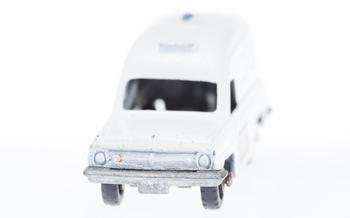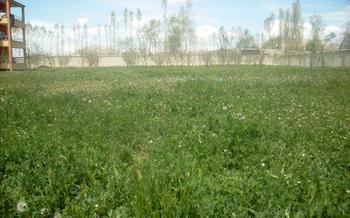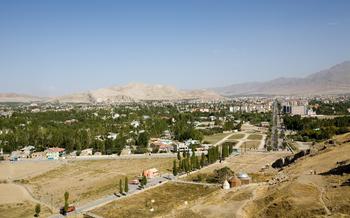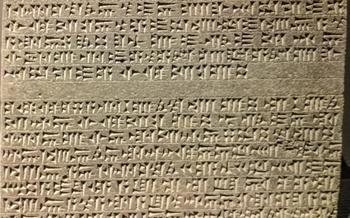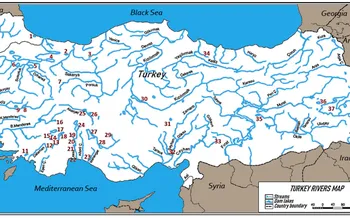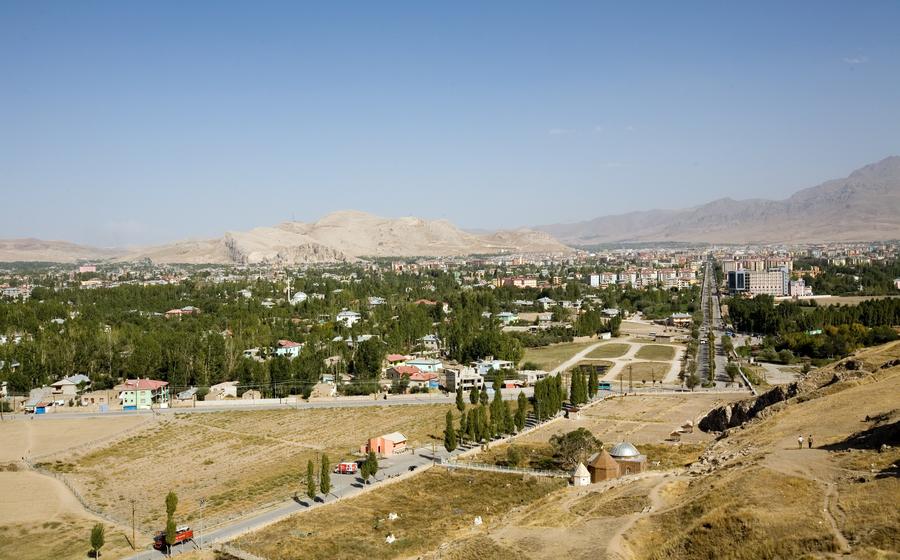
Saray Mound (Saray Höyük)
- History of Saray Mound (Saray Höyük)
- Geographical Location and Accessibility
- Architectural Features
- Artifacts and Findings
- Religious and Cultural Importance
- Admission and Visiting Hours
- Guided Tours and Information
- Accessibility and Facilities
- Photography and Videography
- Safety and Security
- Things to Do Nearby
- Local Cuisine and Dining Options
- Accommodation Options
- Seasonal Considerations
- Insider Tip
History of Saray Mound (Saray Höyük)
The Saray Mound, or Saray Höyük in Turkish, is an archaeological site of immense significance, located in the Van province of Turkey. This ancient mound holds the remnants of a once-thriving settlement that dates back to the Neolithic period, around 7000 BC. Excavations conducted at the site have uncovered a treasure trove of artifacts and structures, providing valuable insights into the cultural development and daily life of the region's earliest inhabitants.
The mound's strategic location, situated on a fertile plain near the shores of Lake Van, made it a prime spot for early settlement. Excavations have revealed a rich timeline of occupation, spanning from the Neolithic period through the Bronze Age, Iron Age, and into the Medieval period. Each cultural layer within the mound tells a unique story, providing glimpses into the evolving lifestyles, technologies, and beliefs of the people who called this place home.
Geographical Location and Accessibility
The Saray Mound (Saray Höyük) is situated in the heart of Van, a city in eastern Turkey renowned for its rich history and cultural heritage. The mound is strategically positioned on a natural elevation within the city limits, making it easily accessible for visitors. To reach the site, one can opt for a leisurely stroll from the city center, immersing themselves in the vibrant local atmosphere. Alternatively, public transportation such as buses or taxis provide convenient options for reaching the mound from various parts of the city.
Once at the site, visitors are greeted by a picturesque panorama of the surrounding landscape. The mound rises prominently above the cityscape, offering breathtaking views of the shimmering Lake Van and the majestic Mount Ararat in the distance. This unique geographical setting enhances the overall experience of exploring the ancient ruins and immersing oneself in the history of Van.
Architectural Features
The Saray Mound boasts an array of intriguing structures that provide glimpses into the architectural prowess of ancient civilizations. The most prominent feature is the citadel, a fortified complex that once served as the administrative and residential center of the site. Its imposing walls and well-preserved gateways offer a testament to the advanced construction techniques employed in its creation.
Within the citadel, visitors can explore the remains of palaces, temples, and storehouses, each showcasing distinct architectural styles and functions. The palaces, adorned with intricate carvings and colorful murals, offer a glimpse into the opulent lifestyle of the ruling elite. The temples, with their elaborate altars and devotional spaces, provide insights into the religious beliefs and practices of the ancient inhabitants.
The mound also features an extensive network of residential buildings, ranging from modest dwellings to grand mansions. These structures, constructed using mudbricks and stone, showcase various architectural styles and provide a glimpse into the daily lives of the ordinary people who inhabited the site.
Overall, the Saray Mound's architectural features offer a fascinating glimpse into the ingenuity and creativity of ancient civilizations, making it a must-visit destination for anyone interested in archaeology and history.
Artifacts and Findings
The excavations at Saray Mound have unearthed a wealth of significant artifacts that provide valuable insights into the cultural and historical heritage of the site. Among the most notable findings are ceramic vessels, stone tools, metal objects, and jewelry. These artifacts showcase the artistic and technological skills of the ancient inhabitants.
The ceramic vessels recovered from the site represent various periods and styles. Some of the earliest pottery dates back to the Neolithic period and exhibits simple forms and decorations. As time progressed, the pottery became more elaborate, featuring painted designs and intricate shapes. These vessels served various purposes, including storage, cooking, and serving food.
Stone tools are another important category of artifacts found at Saray Mound. These tools were crafted from locally available materials such as obsidian and flint. They include scrapers, blades, and arrowheads used for hunting, butchering, and other daily activities. The presence of these stone tools indicates the site's role as a manufacturing center for tools.
Metal objects, such as bronze tools and weapons, are also among the significant findings. The discovery of bronze artifacts suggests that the inhabitants of Saray Mound had mastered metallurgy techniques. These objects include axes, knives, and arrowheads, demonstrating the advanced metalworking skills of the ancient population.
Jewelry items, including beads, pendants, and rings, provide a glimpse into the personal adornment practices of the site's inhabitants. These ornaments were crafted from various materials, including precious metals and gemstones. Their intricate designs and craftsmanship reflect the aesthetic sensibilities of the ancient artisans.
The artifacts discovered at Saray Mound are carefully preserved and displayed in museums and cultural institutions in Van and Turkey. These findings provide invaluable information for archaeologists and historians, helping to reconstruct the daily lives, cultural practices, and technological advancements of the ancient civilizations that once flourished in this region.
Religious and Cultural Importance
Saray Mound holds immense religious and cultural significance, providing insights into the beliefs and practices of ancient civilizations. Excavations have unearthed evidence of religious rituals and ceremonies, including altars, figurines, and votive offerings. These findings suggest that the mound was a sacred site where people gathered to worship and seek divine favor.
The cultural significance of Saray Mound extends beyond its religious aspects. The site has revealed valuable information about the daily lives, customs, and traditions of the people who inhabited the region. Artifacts such as pottery, tools, and jewelry shed light on their artistic expressions, technological advancements, and economic activities.
Understanding the religious and cultural importance of Saray Mound is crucial for appreciating its role in shaping the history and identity of the region. It serves as a testament to the rich cultural heritage of ancient civilizations and their enduring impact on modern society.
Admission and Visiting Hours
Admission to the Saray Mound (Saray Höyük) is free of charge, allowing visitors to explore the ancient site without any financial constraints. The mound is open to the public daily during daylight hours, providing flexibility for tourists to plan their visit at a convenient time.
Summer Season: During the summer months, from April to October, the site is accessible from 8:00 AM to 8:00 PM, allowing visitors to take advantage of the extended daylight hours for a thorough exploration.
Winter Season: In the winter months, from November to March, the site is open from 9:00 AM to 5:00 PM, accommodating visitors with shorter daylight hours while still providing ample time to explore the mound's wonders.
To make the most of your visit, it is recommended to plan your trip during the mornings or late afternoons to avoid the midday heat, especially during the summer months.
Guided Tours and Information
Saray Mound offers guided tours for visitors seeking deeper insights into its history and significance. Conducted in various languages, these tours provide a structured and informative experience, allowing visitors to delve into the rich tapestry of ancient civilizations that once flourished here.
While some travelers prefer the flexibility of self-guided exploration, guided tours offer a more immersive and educational experience. Knowledgeable guides lead visitors through the site, providing historical context, explaining the significance of discoveries, and answering questions along the way.
Reservations for guided tours can be made in advance through the official website or by contacting the visitor center directly. On-site tour arrangements may also be possible, subject to availability. For self-guided tours, informative brochures and guidebooks are available for purchase at the visitor center. These materials provide maps, historical overviews, and detailed descriptions of the site's features, allowing visitors to navigate and learn independently.
Accessibility and Facilities
The Saray Mound is committed to ensuring accessibility and inclusivity for all visitors. Individuals with disabilities can easily navigate the site thanks to designated ramps and accessible pathways. Restrooms and seating areas are strategically located for convenience and comfort. For those who need refreshment, there are designated areas within the site where they can purchase snacks and beverages. Additionally, a gift shop is available for visitors to purchase souvenirs and mementos to cherish their visit.
Photography and Videography
Photography and videography are permitted within designated areas of the Saray Mound (Saray Höyük), allowing visitors to capture the beauty and significance of the site. While documenting your visit, it is essential to respect the privacy of other visitors and avoid disturbing the ongoing excavations or restoration work.
Permitted Areas:
- Visitors can take photos and videos in the open areas of the site, including the surrounding landscape and the excavated structures.
- Specific areas may be restricted for photography or videography due to ongoing research or conservation efforts. Please adhere to any signs or instructions provided by the site staff.
Respecting Privacy:
- Be mindful of other visitors and avoid taking photos or videos that may intrude on their privacy or disrupt their experience.
- Refrain from using flash photography, as it can be disruptive and damaging to the artifacts.
Commercial Photography and Videography:
- Commercial photography or videography for professional or commercial purposes requires prior permission from the authorities. Please contact the site management or relevant tourism offices for necessary permits and guidelines.
Safety and Security
The Saray Mound is a well-maintained and safe site for visitors. General safety measures are in place to ensure a pleasant and secure experience. Visitors are advised to follow the designated paths and avoid climbing or entering restricted areas. It is essential to be mindful of uneven surfaces and potential tripping hazards within the archaeological site. Emergency contacts and procedures are clearly displayed throughout the premises. In case of any concerns or emergencies, visitors should immediately notify the site staff or seek assistance from local authorities. Responsible behavior while exploring the site is highly encouraged, respecting the historical significance and preserving the integrity of the ancient ruins.
Things to Do Nearby
The Saray Mound may be the main attraction in the area, but there are many other fascinating places to explore in the vicinity. History buffs can delve deeper into Van's rich past by visiting the Van Museum, which houses an impressive collection of artifacts from the region's ancient civilizations. Nature enthusiasts can embark on a scenic hike in the nearby Mount Süphan National Park, home to breathtaking landscapes and diverse wildlife.
For those seeking a cultural experience, the vibrant city of Van offers a plethora of options. Stroll through the bustling local markets, where you can haggle for souvenirs and sample delicious street food. Savor the flavors of traditional Turkish cuisine at one of the many restaurants in the city center. Don't miss the opportunity to indulge in the local specialty, Van kebab, known for its unique blend of spices and tender meat.
If you're looking for a relaxing respite, head to Van Lake, the largest lake in Turkey. Take a leisurely boat trip to admire the stunning scenery and spot the numerous bird species that call the lake home. Alternatively, find a quiet spot along the shore to soak up the sun and enjoy a picnic with friends or family.
Local Cuisine and Dining Options
Taste the Delights of Van's Culinary Heritage
Van offers a culinary journey that will tantalize your taste buds and introduce you to the region's rich cultural heritage. Indulge in traditional dishes that showcase fresh, local ingredients and unique flavors. Don't miss the opportunity to savor dishes like "Van Kahvaltısı", a lavish breakfast spread featuring an array of local delicacies, including cheeses, honey, and freshly baked bread. For a taste of traditional Turkish cuisine, try "Van Tavası", a hearty casserole made with tender lamb, vegetables, and spices.
Recommended Restaurants and Eateries
Near the Saray Mound, you'll find a range of dining options to satisfy your cravings. For a casual and authentic experience, try "Şeref Büryan", renowned for its mouthwatering "büryan", a slow-cooked lamb dish that melts in your mouth. If you prefer a more upscale ambiance, "Van Gölü Balık Evi" offers a delightful selection of fresh seafood dishes, including grilled trout from Lake Van.
Picnic Perfection
For a memorable dining experience, consider packing a picnic and heading to one of the scenic spots near the Saray Mound. The tranquil shores of Lake Van provide a breathtaking backdrop for a leisurely picnic. Spread out your blanket and savor local delicacies while enjoying the serene beauty of the surroundings.
Accommodation Options
When planning your trip to Van and the Saray Mound, you'll need to consider your accommodation options. The city offers a range of hotels and guesthouses to suit different budgets and preferences. For the ultimate convenience, opt for accommodations within walking distance or a short drive from the Saray Mound. This way, you can easily explore the site without worrying about transportation.
Numerous hotels in Van provide comfortable rooms with modern amenities. Whether you seek a budget-friendly option or a luxurious stay, you'll find suitable accommodations to meet your needs. Check online booking platforms or consult with local travel agencies to compare prices, amenities, and availability.
To enhance your experience, consider guesthouses or boutique hotels that offer a more authentic and immersive stay. These accommodations often showcase traditional Turkish architecture and hospitality, allowing you to delve deeper into the local culture. Some guesthouses even provide rooftop terraces with panoramic views of the city and the surrounding landscapes, creating a memorable backdrop for your stay.
Remember to book your accommodation in advance, especially if you're visiting during peak tourist season. This will ensure that you secure a comfortable and convenient place to rest after your explorations at the Saray Mound.
Seasonal Considerations
The best time to visit Saray Mound is during the spring (April-May) and autumn (September-October) when the weather is generally mild and pleasant. During these months, visitors can comfortably explore the ruins without having to endure the scorching heat of summer or the harsh cold of winter.
Winter (November-March) can be quite chilly in Van, with temperatures dropping below freezing. Snowfall is common, and the site may be covered in a blanket of white. While this can create a picturesque winter wonderland, it can also make exploring the ruins more challenging due to slippery surfaces and limited visibility.
Summer (June-August) is the hottest season in Van, with temperatures often soaring above 30 degrees Celsius. The intense heat can be uncomfortable for sightseeing, and the ruins may become crowded with tourists seeking relief from the sun. Additionally, some areas of the site may be closed for maintenance or restoration work during the summer months.
It's important to note that the weather in Van can be unpredictable, and visitors should be prepared for sudden changes in temperature and precipitation. It's advisable to dress in layers and carry an umbrella or raincoat, especially during the spring and autumn months.
Insider Tip
Hidden Gems and Unique Experiences:
-
Secret Chamber: Explore the hidden chamber beneath the main temple, accessible through a concealed entrance. Discover ancient inscriptions and artifacts not visible to regular visitors.
-
Sunrise Panorama: Arrive early to witness the mesmerizing sunrise over the Van plain from the top of the mound. Capture stunning panoramic shots of the surrounding landscape bathed in golden light.
-
Local Craftsmanship: Visit the nearby village of Ahlat to witness traditional craftsmanship and purchase handmade souvenirs, such as intricate carpets, pottery, and jewelry, directly from local artisans.
-
Respect Local Customs: Show respect for local traditions by dressing modestly and avoiding loud noises or disruptive behavior. Engage with the friendly locals to learn about their customs and history.


